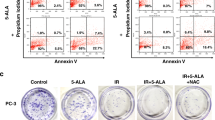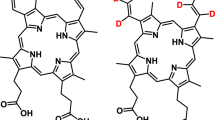Summary
We have studied the effects of hypoxia on aminolaevulinic acid (ALA)-induced protoporphyrin IX (PpIX) synthesis in EMT6 monolayer cultures characterized by different cell densities and proliferation rates. Specifically, after ALA incubation under hypoxic or normoxic conditions, we detected spectrofluorometrically the PpIX content of the following populations: (a) low-density exponentially growing cells; (b) high-density fed-plateau cells; and (c) high-density unfed-plateau cells. These populations were selected either for the purpose of comparison with other in vitro studies (low-density exponentially growing cells) or as representatives of tumour regions adjacent to (high-density fed-plateau cells) and further away from (high-density unfed-plateau cells) capillaries. The amount of PpIX per cell produced by each one of these populations was higher after normoxic ALA incubation. The magnitude of the effect of hypoxia on PpIX synthesis was dependent on cell density and proliferation rate. A 42-fold decrease in PpIX fluorescence was observed for the high-density unfed-plateau cells. PpIX production by the low-density exponential cells was affected the least by ALA incubation under hypoxic conditions (1.4-fold decrease), whereas the effect on the high-density fed-plateau population was intermediate (20-fold decrease).
Similar content being viewed by others
Article PDF
Change history
16 November 2011
This paper was modified 12 months after initial publication to switch to Creative Commons licence terms, as noted at publication
References
Bech, Ø, Berg, K. & Moan, J. (1997). The pH dependency of protoporphyrin IX formation in cells incubated with 5-aminolevulinic acid. Cancer Lett 113: 25–29.
Bermúdez Moretti, M., Correa García, S., Stella, C., Ramos, E. & Del C Batlle, A. M. C. (1993). δ-aminolevulinic acid transport in Saccharomyces cerevisiae. Int J Biochem 25: 1917–1924.
Crow, E. L., Davis, F. A. & Maxfield, M. W. (1960). Statistics Manual, Dover Publications: New York
Dietel, W., Bolsen, K., Dickson, E., Fritsch, C., Pottier, R. & Wendenburg, R. (1996). Formation of water-soluble porphyrins and protoporphyrin IX in 5-aminolevulinic-acid-incubated carcinoma cells. J Photochem Photobiol B Biol 33: 225–231.
Falk, J. E., Porra, R. J., Brown, A., Moss, F. & Larminie, H. E. (1959). Effect of oxygen tension on haem and porphyrin biosynthesis. Nature 184: 1217–1219.
Fingar, V. H., Wieman, T. J., McMahon, K. S., Haydon, P. S., Halling, B. P., Yuhas, D. A. & Winkelman, J. W. (1997). Photodynamic therapy using a protoporphyrinogen oxidase inhibitor. Cancer Res 57: 4551–4556.
Fukuda, H., Batlle, A. M. C. & Riley, P. A. (1993). Kinetics of porphyrin accumulation in cultured epithelial cells exposed to ALA. Int J Biochem 25: 1407–1410.
Gibson, S. L., Havens, J. J., Foster, T. H. & Hilf, R. (1997). Time-dependent intracellular accumulation of δ-aminolevulinic acid, induction of porphyrin synthesis and subsequent phototoxicity. Photochem Photobiol 65: 416–421.
Gibson, S. L., Cupriks, D. J., Havens, J. J., Nguyen, M. L. & Hilf, R. (1998). A regulatory role for porphobilinogen deaminase (PBGD) in δ-aminolaevulinic acid (δ-ALA)-induced photosensitization? Br J Cancer 77: 235–243.
Hanania, J. & Malik, Z. (1992). The effect of EDTA and serum on endogenous porphyrin accumulation and photodynamic sensitization of human K562 leukemic cells. Cancer Lett 65: 127–131.
Iinuma, S., Farshi, S. S., Ortel, B. & Hasan, T. (1994). A mechanistic study of cellular photodestruction with 5-aminolevulinic acid-induced porphyrin. Br J Cancer 70: 21–28.
Kennedy, J. C. & Pottier, R. H. (1992). Endogenous protoporphyrin IX, a clinically useful photosensitizer for photodynamic therapy. J Photochem Photobiol B Biol 14: 275–292.
Kennedy, J. C., Pottier, R. H. & Pross, D. C. (1990). Photodynamic therapy with endogenous protoporphyrin IX: basic principle and present clinical experience. J Photochem Photobiol B Biol 6: 143–148.
Kennedy, J. C., Marcus, S. L. & Pottier, R. H. (1996). Photodynamic therapy (PDT) and photodiagnosis (PD) using endogenous photosensitization induced by 5-aminolevulinic acid (ALA): mechanisms and clinical results. J. Clin Laser Med Surg 14: 289–304.
Krammer, B. & Überriegler, K. (1996). In-vitro investigation of ALA-induced protoporphyrin IX. J Photochem Photobiol B: Biol 36: 121–126.
Kriegmair, M., Baumgartner, R. & Knüchel, R. (1994). Fluorescence photodetection of neoplastic urothelial lesions following intravesical instillation of 5-aminolevulinic acid. Urology 44: 836–841.
Moan, J., Bech, Ø, Gaullier, J-M, Stokke, T., Steen, H. B., Ma, L. W. & Berg, K. (1998). Protoporphyrin IX accumulation in cells treated with 5-aminolevulinic acid: dependence on cell density, cell size and cell cycle. Int J Cancer 75: 134–139.
Momma, T., Hamblin, M. R. & Hasan, T. (1997). Hormonal modulation of the accumulation of 5-aminolevulinic acid-induced protoporphyrin and phototoxicity in prostate cancer cells. Int J Cancer 72: 1062–1069.
Peng, Q., Warloe, T., Berg, K., Moan, J., Kongshaug, M., Giecksky, K-E & Nesland, J. M. (1997). 5-Aminolevulinic acid-based photodynamic therapy. Cancer 79: 2282–2308.
Poulson, R. (1976). The enzymic conversion of protoporphyrinogen IX to protoporphyrin IX in mammalian mitochondria. J Biol Chem 251: 3730–3733.
Poulson, R. & Polglase, W. J. (1975). The enzymic conversion of protoporphyrinogen IX to protoporphyrin IX. J Biol Chem 250: 1269–1274.
Rebeiz, N., Rebeiz, C. C., Arkins, S., Kelley, K. W. & Rebeiz, C. A. (1992). Photodestruction of tumor cells by induction of endogenous accumulation of protoporphyrin IX: enhancement by 1,10-phenanthroline. Photochem Photobiol 55: 431–435.
Rittenhouse-Diakun, K., van Leengoed, H., Morgan, J., Hryhorenko, E., Paszkiewicz, G., Whitaker, J. E. & Oseroff, A. R. (1995). The role of transferrin receptor (CD71) in photodynamic therapy of activated and malignant lymphocytes using the heme precursor δ-aminolevulinic acid (ALA). Photochem Photobiol 61: 523–528.
Sano, S. & Granick, S. (1961). Mitochondrial coproporphyrinogen oxidase and protoporphyrin formation. J Biol Chem 236: 1173–1180.
Schick, E., Kaufmann, R., Rück, A., Hainzl, A. & Boehncke, W-H (1995). Influence of activation and differentiation of cells on the effectiveness of photodynamic therapy. Acta Derm Venereol 75: 276–279.
Schoenfeld, N., Epstein, O., Lahav, M., Mamer, R., Shaklai, M. & Atsmon, A. (1988). The heme biosynthetic pathway in lymphocytes of patients with malignant lymphoproliferative disorders. Cancer Lett 43: 43–48.
Steinbach, P., Weingandt, H., Baumgartner, R., Kriegmair, M., Hofstädter, F. & Knüchel, R. (1995). Cellular fluorescence of the endogenous photosensitizer protoporphyrin IX following exposure to 5-aminolevulinic acid. Photochem Photobiol 62: 887–895.
Tan, W. C., Krasner, N., O’Toole, P. & Lombard, M. (1997). Enhancement of photodynamic therapy in gastric cancer cells by removal of iron. Gut 41: 14–18.
Tsai, M. A., Waugh, R. E. & Keng, P. C. (1996). Cell cycle-dependence of HL-60 cell deformability. Biophys J 70: 2023–2029.
Vaupel, P., Kallinowski, F. & Okunieff, P. (1989). Blood flow, oxygen and nutrient supply, and metabolic microenvironment of human tumors: a review. Cancer Res 49: 6449–6465.
Wyld, L., Burn, J. L., Reed, M. W. R. & Brown, N. J. (1997). Factors affecting aminolaevulinic acid-induced generation of protoporphyrin IX. Br J Cancer 76: 705–712.
Wyld, L., Reed, M. W. R. & Brown, N. J. (1998). The influence of hypoxia and pH on aminolaevulinic acid-induced photodynamic therapy in bladder cancer cells in vitro. Br J Cancer 77: 1621–1627.
Author information
Authors and Affiliations
Rights and permissions
From twelve months after its original publication, this work is licensed under the Creative Commons Attribution-NonCommercial-Share Alike 3.0 Unported License. To view a copy of this license, visit http://creativecommons.org/licenses/by-nc-sa/3.0/
About this article
Cite this article
Georgakoudi, I., Keng, P. & Foster, T. Hypoxia significantly reduces aminolaevulinic acid-induced protoporphyrin IX synthesis in EMT6 cells. Br J Cancer 79, 1372–1377 (1999). https://doi.org/10.1038/sj.bjc.6690220
Received:
Revised:
Accepted:
Published:
Issue date:
DOI: https://doi.org/10.1038/sj.bjc.6690220
Keywords
This article is cited by
-
Dormant cancer cells accumulate high protoporphyrin IX levels and are sensitive to 5-aminolevulinic acid-based photodynamic therapy
Scientific Reports (2016)
-
Selective 5-aminolevulinic acid-induced protoporphyrin IX fluorescence in Gliomas
Acta Neurochirurgica (2016)



